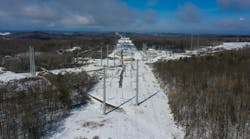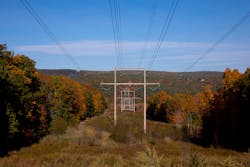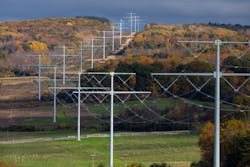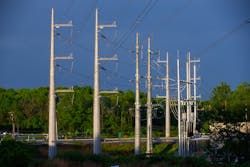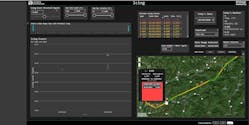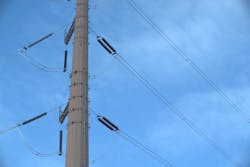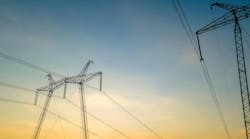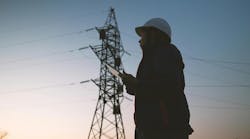During frigid days and pop-up winter storms, electricity demand can rise precipitously, with brutal and hazardous ambient weather conditions and congestion on transmission circuits to specific nodes. Loads can increase rapidly in regions under these conditions. For example, during winter storm Elliott in December 2022, temperatures dropped 30 degrees in a matter of hours in Denver, Colorado; the freezing line dropped as far south as Mobile Bay, Alabama, which partially froze; and Mount Washington in New Hampshire experienced a 151-mph (243-kmph) wind gust.
Events such as Elliott mean utilities must place a high importance on knowing the condition of transmission conductors, which are always susceptible to axial, bending moment and shear stresses as well as causing or experiencing cascading power failures. Even when generation resources remain online — which is often not the case, especially with natural gas-fueled units — ice and snow accretions can cause transmission lines to sag or a break in a line, or they can bend the transmission towers on both sides, taking a good portion of the network with them. Once faults or damages occur, they can take hours or days to resolve. Even short-duration power outages can impact the public’s comfort, health and ability to work, especially in the post-COVID work-from-home era. Moreover, extended outages can cause substantial individual monetary and business loss, larger economic impacts and negative health-related consequences.
There is more of this weather to come. A recent National Oceanic and Atmospheric Administration (NOAA) study by its Modeling, Analysis, Predictions, and Projections (MAPP) program determined that “weaker Arctic polar vortex conditions and stretching disruptions are increasing in frequency for October through February” in the U.S. In the tight grid conditions that often occur during such events, utilities may need to deenergize conductors or even suffer failures, potentially causing blackouts across large areas in bitter cold. This is a major challenge for utilities that own and maintain transmission infrastructure.
Given so many recent occurrences of what used to be referred to as 100- and even 1000-year weather events, it is important to consider how cold winters, a common occurrence in Upstate New York, may adversely affect the reliability of an already stressed and congested grid. In the face of these unprecedented challenges, the New York Power Authority (NYPA), the largest state public power organization in the U.S., launched its VISION2030 strategic plan to help lead the transition to a carbon-free, economically vibrant New York through customer partnerships, innovative energy solutions and the responsible supply of affordable, clean and reliable electricity. NYPA works with technology partners to modernize and harden its transmission assets while maximizing existing grid capacity to accelerate the path to a carbon-free grid.
Transmission Line Health
Selected as the winner of the competitive 2021 NYPA & Israel Smart Energy Challenge, one example of that emerging technology exploration is NYPA’s work with Prisma Photonics, a Tel Aviv-based company that offers power grid monitoring and preventive solutions that use a specific type of fiber-optic sensing — called Hyper-Scan Fiber-Sensing — based on the principles of distributed acoustic sensing (DAS). This technology identifies power line conditions in real time, detecting potential threats to the system, including weather conditions, electrical faults and even sabotage by human activity in proximity to towers.
The Hyper-Scan Fiber-Sensing system uses existing fiber-optic ground wire (OPGW) that sits on top of power lines, connecting the ground wire to an optical interrogator that sits in a substation and analyzes signals from the fiber to sense what is happening on power lines. The analyzer detects and classifies events, pinpoints them to individual tower locations with unprecedented accuracy and avoids the nuisance of false alarms.
The interrogator transmits optical pulses that propagate down the fiber, reflecting a minute fraction of light along each point by taking advantage of a physical phenomenon called Rayleigh scattering, the dispersion of electromagnetic radiation by particles that have a radius less than approximately one-tenth the wavelength of the radiation. The interrogator then measures the reflected light to determine the line
attributes over hundreds of miles.
Beginning in the winter of 2021, NYPA embarked on a project with Prisma Photonics using its PrismaPower technology to monitor the transmission line from a substation in Gilboa, New York, to another substation in Fraser, New York, climbing the Catskill Mountains for more than 35 miles (56 km). Due to its position, this line experiences a wide range of weather conditions, including especially harsh winters with very cold temperatures, significant snowfall and powerful winds.
This initiative provides NYPA with a tool to identify specific problems before they become serious and enables the utility to plan preventive maintenance, improving both grid reliability and resilience. To this end, PrismaPower can identify a power line’s health at granular levels, including in weather-related conditions such as line galloping, sagging and high winds. It also identifies potentially catastrophic events, including flashovers, short circuits, partial discharges, vegetation strikes, and even tower climbing and vandalism.
Perhaps most importantly, this technology does not require adding extra sensors to the transmission infrastructure or any amplification or power sources along the fiber.
For nearly two years, Prisma Photonics collected data in the Upstate New York region over rugged mountains, through thick forests, and in the most extreme heat and cold. This data collection has allowed for deep comparative analysis, making it possible to see the effects that different weather conditions have on the grid.
For example, during the project, hits from all types of anomalistic behaviors were detected and identified on specific power line towers. Simulated sabotage events, such as tower climbing carried out by linemen, were detected as well, pointing to a specific tower.
From a preventive maintenance perspective, long-term analysis was performed to locate and create a threshold mechanism to identify high partial-discharge levels in specific towers. Towers with high partial-discharge levels can be treated separately before the matter becomes more serious (for example, by insulator washing or replacements). In the future, this analysis can help with optimizing maintenance by handling the needed towers.
Detecting Ice
Perhaps most important to NYPA’s efforts to deliver reliable service in areas of New York that get extremely cold is Prisma Photonics’ ability to detect icing on line spans. Data captured directly from the lines through fiber sensing was correlated with weather information.
When cable tension in a specific span is high along with the right weather conditions (for instance, low temperatures and high precipitation), this is a good indicator of icing. In an icing dashboard, spans with suspected high icing loads are presented on a map and, by picking them, tower data can be seen. Having real-time notification of icing alerts enables NYPA to act and correct the situation before any damage is done to the asset.
In addition to the work NYPA is doing on icing, there are, of course, considerably more benefits that can be realized with large-scale, continuous monitoring of power lines. The utility can use the technology to detect wildfires, high winds and other extreme weather events that can affect the reliability of the grid.
Ongoing Innovation
Using technology to monitor power lines is not new. Many transmission system operators (TSOs) have deployed fixed cameras as well as thermal, corona, light detection and ranging, and regular photographic sensors on high-voltage lines. Others have used helicopters, drones and human inspection, or a combination of these options. However, these technologies are limited in their ability to scale, and there is a low frequency and level of detail at which they can measure the condition and performance of conductors.
This effort plays an integral role in supporting one of NYPA’s five strategic priorities in New York’s energy transformation: to be the leading transmission developer, owner and operator in the state of New York. NYPA owns, operates and maintains 1460 circuit-miles of the transmission grid, managing this system continually feeding energy from power plants and renewable energy resources to distribution centers and consumers. A reliable grid is essential to everyone’s daily lives and typically operates in the background. Too often, it is taken for granted until it stops working. Once electric service stops, it disrupts people’s lives in ways that can range from annoying to life-threatening.
Strengthening transmission serves NYPA’s goals in battling climate change and ensuring environmental justice in communities across the state, integrating an environmental, social and governance framework into the utility’s DNA, and expanding its sustainability efforts to achieve better results. The utility is working tirelessly to address these challenges and embrace opportunities as it helps New Yorkers to meet the state’s climate goals, while providing ratepayers with the most reliable, resilient and affordable grid possible.
Alan Ettlinger, P.E., is senior director of research, technology development and innovation at New York Power Authority.
